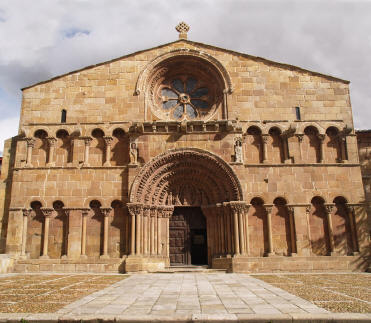 Believe it or not, a country that receives over 55 million tourists a year and has mass development on its costas is also home to the least populated region in Europe. Soria, called by some the forgotten corner of Spain is that place. Forgotten by mass development and hordes of tourists, Soria has managed to retain its charm and beauty and offers her visitors an escape from the hectic pace of modern life.
Believe it or not, a country that receives over 55 million tourists a year and has mass development on its costas is also home to the least populated region in Europe. Soria, called by some the forgotten corner of Spain is that place. Forgotten by mass development and hordes of tourists, Soria has managed to retain its charm and beauty and offers her visitors an escape from the hectic pace of modern life.
The province of Soria lies on the most easterly limits of the autonomous region of Castilla y Leon, central Northern Spain. Its 10,000 sq km (3861 miles) of beautiful landscapes and diverse geography, act as a backdrop to the large concentration of medieval castles, Romanesque churches and timeless medieval villages. All of which are in close proximity to each other.
Known for pure clean air, due to its expanse of forests, nature parks, grazing lands and lack of heavy industry, it's the perfect place to slow down and reconnect with the natural environment.
The province has a population of approx 93,000, of which 40% live in its capital, also called Soria. With population density at 8.8 inhabitants per sq km compared with an average in Spain of 87.2 and 116 in Europe, Soria is one of the least populated areas of Europe and a fantastic destination to unwind.
With its abundance of charm and tranquillity, Soria beckons you to explore its nature, medieval castles, forests, history and gastronomy. Sorias attractions can be visited without spending your precious holiday time standing in queues or paying outrageously high entry fees with most museums, castles and hermitages charging only 0.60 to 2.00 euros per person for entrance, and to date we have never experienced a queue.
To the north of the province lies the 'Picos Urbion' mountain range, often snow capped in winter. This mountain range cradles the awe inspiring glacial lake Laguna Negra (Black Lake) and nearby the mountains give birth to the mighty Rio Duero (River Duero) which eventually ends its course on the coast of Portugal.
To the west the Rio Lobos (River of Wolves) has carved its way through the limestone to create the Canyon Rio Lobos protected natural park. The canyon walls rise to heights of 200 metres (656 ft) in places, and the sunburst red and cream hues add another colour to your surrounds. Take time to contemplate why the Knights Templar built their isolated hermitage here. The most recent wildlife census recorded over 200 pairs of Griffon Vultures in the Canyon, where you'll all so find Red Deer, Roe Deer, Wild Boar, Otters, Minks, Golden Eagles and many other species of flora and fauna.
To the South East the River Duero starts to mature and nourishes the first vines in the wine region of the Ribera del Duero, home of the highly prized Vega Sicilia wine. It was through these lands that the Castilian hero El Cid travelled. As these were the frontier lands of the 'Reconquista' (the re conquering of Spain), its not surprising this is where you will see the greatest concentration of medieval castles in Europe.
The land again changes as you head south and reach the medieval town of Medinaceli, another highlight with its mighty Roman arch, the only one of its kind in Spain. The weathered limestone formations nearby, with their intense red surface remind us of the spaghetti westerns that were filmed here, due to its similarity to the deserts of the North America.
Agreda to the east has its Arab and Jewish influences, the Jewish quarter still very much intact. It is here you find the highest mountain in Soria, Moncayo that rises to 2313m (7588 feet).
The Soria province and its city were the endless inspiration of many well known poets and romancers, like Machado, Diego and Bécquer, who were enchanted by its beauty and history. It was here the world famous 12 - 13th Century epic poetry, 'Cantar del Cid' (Lay of Cid) was written.
Film directors have also fallen for Sorias charm and beauty. Several films were shot in Soria. David Lean's classic Dr Zhivago for one, as well as Orson Wells's Shakespeare epic 'Chimes at Midnight', both making use of the quaint medieval village of Calatañazor.
Soria is developing as a rural destination for lovers of nature, history, leisure walkers and ramblers. Here you will find a network of over 500kms of walking tracks, where you can walk in the footsteps of El Cid, following along roman roads or routes connecting the Ataylas (Arab communications towers) or visit the inspirational places of Spanish poets, such as Antonio Machado.
In springtime the wild flowers are in full blossom and fill the countryside with colour. Wild Orchids, Iris, Peony as well as wild Thyme, Sage and Lavender carpet the grazing lands and fill the air with their heavenly scents. Summers temperatures tend to rise considerably though evenings are cool. During autumn the vegetation becomes an array of golds, browns and reds, wild deer can be heard bellowing and the wild mushrooms appear in abundance.
The best time of year to enjoy Soria is spring, summer or autumn; however the blue skies and snow of winter add a touch of magic to the landscape.
Visit my photo gallery if you'd like to see some pictures of this fantastic corner of Northern Spain.